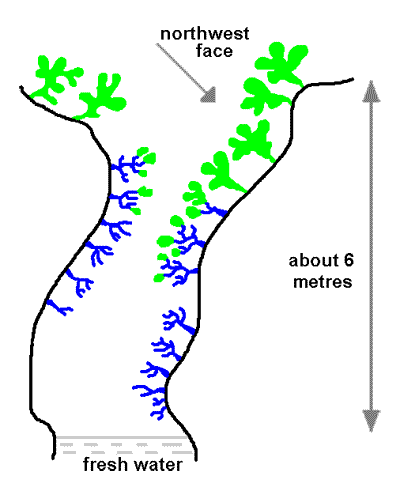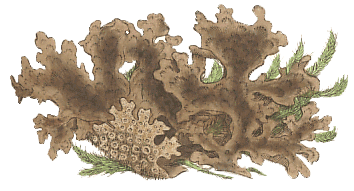Form and structure
Sticta and 'Dendriscocaulon'
Sticta filix is a foliose lichen with an algal photobiont and Dendriscocaulon was initially described as a fruticose genus with a cyanobacterial photobiont and in each genus fungal tissue dominates the thallus. However, you can find lobes of Sticta filix growing from branched Dendriscocaulon thalli and microscopic examination has shown that in such cases there is continuity between the fungal partner. That is, it is the same fungus in both the fruticose and foliose thalli, rather than the foliose Sticta thalli being parasitic or epiphytic on the fruticose Dendriscocaulon. Since lichens are classified by the fungal partner what we have is the same species of lichen showing two strikingly different growth forms, depending on the photobiont. Of course, since a species may have only one name this lichen cannot be both a species of Sticta and a species of Dendriscocaulon. The genus Sticta was introduced in 1803 and Dendriscocaulon in 1885. Given the dramatic difference in thallus form it's not surprising that two separate genera were erected. Where two supposedly different species are found to be the same species, the species name published earlier would generally take priority and so be considered the correct name for the species in question. In the example being considered here Sticta filix takes priority, so that is the name of this species with two different thallus morphologies. Over time the descriptions of a number of Dendriscocaulon species were published but some of those species have been shown to be fruticose forms of foliose lichens with algal photobionts. It may be that all the Dendriscocaulon species are in fact fruticose variants of foliose species (in the genera Sticta, Lobaria or Pseudocyphellaria) and that none are really species in their own right. Therefore a number of lichenologists will write 'Dendriscocaulon', the inverted commas indicating doubts as to the nature of this supposed genus. Others will talk of the fruticose thallus as the Dendriscocaulon-form of some other, foliose species.
A very striking example of Sticta /'Dendriscocaulon' thallus variation was found in 1962 near Te Anau on the South Island of New Zealand and the setting is shown in the following diagram.

The branching blue structures indicate the fruticose 'Dendriscocaulon' form of Sticta filix and the green lobed bits indicate the foliose form. The lichens are growing from the surfaces of two very large boulders that have a narrow gap between them. The boulders are in the spray zone of a small waterfall which may have considerable flow when the nearby river is in full spate. The boulders are shaded by overhanging trees but the upper areas may receive up to five hours of sunshine per day, between October and May. The lower parts of the boulders are in permanent shade. A total of 93 thalli were found (24 algal, 38 cyanobacterial and 31 composites) distributed in the zones as indicated by the above diagram (by green, blue and blue-&-green respectively). Apothecia were found only on some of the upper thalli with the algal photobiont. The evidence suggests that by being able to combine with both an alga and a cyanobacterium the fungus can occupy a wider range of habitats than it would be able to do if it combined with only one type of photobiont![]() .
.
The fruticose-foliose dimorphism in Sticta was first observed by the Reverend Francis Wilson, in specimens of Sticta stipitata that he'd collected from Mount Macedon in Victoria in the 1880s. He had observed the fruticose-foliose dimorphism a number of times between 1886 and 1889 and published his observations in 1891. The paper was titled 'Notes on a remarkable lichen growth in connection with a new species of Sticta - with descriptions of both' and appeared on pages 8-11 of volume 7 of the Proceedings of the Royal Society of Queensland. You can read a PDF of that paper by following this LINK.
Form and structure pages on this website Crustose lichens |
![An Australian Government Initiative [logo]](/images/austgovt_brown_90px.gif)


